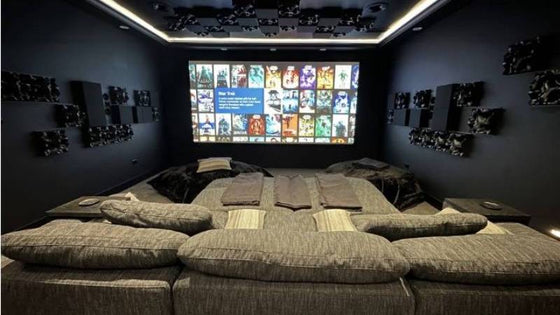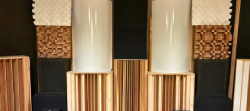Creating a system you love shouldn't be difficult. The Acoustic Frontiers blog is here to help.
This article will look at the different options available for setting up a wired or wireless home network. We'll explore some of the factors that are making home networks more important in our day to day lives and discuss the pros and cons of the wired and wireless solutions out there such as powerline ethernet, ethernet over coaxial cable and high powered wireless access points.
For the purposes of this article we're going to assume you have a fast internet connection suitable for media streaming that comes into your home in a single physical location.
In the last couple of years there has been a clear trend for more and more of our home entertainment devices to come with an ethernet connection - either wired or wireless. In a broader sense we can say it is IP (Internet Protocol) enabled. This functionality has been included primarily to enable media streaming, although recently manufacturers have started to incorporate IP control.
Media streaming built into blu-ray players, 'smart TVs' and home theater receivers, allows playback of content from a number of sources including:
Netflix - a major driver of the need for IP connectivity
Control. Some of the recent projects I have installed have been a Bryston BDP-1 which allows selection of media, creation of playlists and the like via a computer or iDevice and a Marantz AV7005 which can be controlled via a an iDevice. Manufacturers are also starting to build the capability for integration of their devices with popular home automation systems, such as those by Control 4. The big benefit to properly excecuted IP control systems are that they are two way, or bi-directional. Traditional control is one-way; you point the remote at the receiver and press volume up. The volume goes up but you don't know by looking at the remote what volume the receiver is set to. Two way control would provide feedback to your remote to let you know what volume level the receiver is now at.
The Control 4 iPad app
The key issue that faces us in this new world of IP connectivity is that the majority of our homes are not wired for this new paradigm - the "Connected Home". Up until the last couple of years the only place we would really need a connection is to our personal computer. Fast forward three years and it is likely that most electronics will come with IP capability. In fact it won't only be our AV systems that will need an IP connection, since we are also seeing household appliances such as refrigerators starting to come with IP. Fast forward five years and you can see a situation where everything in your home from light switches to door locks to coffee makers are IP connected and controllable via a home automation system. The question then becomes: what options do we have, both wired and wireless, for enabling the "Connected Home"?
There are quite a few different wired options out there for sorting out the IP connectivity dilemma. Let's briefly look at a few:
Run new ethernet cabling. This solution is going to be expensive because it means running new cables. However it has the highest bandwidth potential out of all the options here, with Gigabit (1000mbits/sec) speeds possible (not that you will need these for watching Netflix...).
Use existing coaxial cables. MoCA (Multimedia over Coax) is a technology that allows IP over the coax cable in your house. If your local cable company pulled cables into quite a few rooms in your house already then this might be the way to go. WipNet make a product that fits into a standard single gang low voltage box and allows you to keep on using the cable for TV whilst also enabling IP control and internet access for streaming. Rates top out around 170mbits/sec.
Home Plug Alliance. The newer versions of the technology have enough bandwidth to support a Netflix streaming connection with some manufacturers claiming 200mbits/sec. These devices are susceptible to power line noise which can reduce bit rates quite a bit relative to theoretical conditions.
access point (AP) is a device that provides wireless access to your network. Most often consumer level APs - the kind you pick up at Best Buy - are integrated into a single box with a router. The router is the device that connects your local area network (LAN) to the wide area network (WAN; in other words the internet). The issue with these types of boxes is that they have low broadcast power and therefore low range. If you have a typical family home chances are you are not going to have even and strong wireless coverage. There will be some areas that have good coverage and other areas that have low data speeds and patchy coverage.
D Link Dir-655; a typical consumer wireless access point / router
Wireless Distribution System. The idea is that you set up all of your APs with the same SSID (Service Set Identifier - the name of the wireless network) so that theoretically your mobile device or tablet will latch on to the most powerful signal as you walk around your home without you having to manually swap from one SSID to another. The downside (and its a big downside) is that most wireless devices 'hold onto' the AP that they first connect to even when its signal is a lot weaker than that being broadcast from another AP. The other major issues with this approach is the hardwiring needed to connect all of the APs together. If you choose to use WDS then you have to be aware that there is no standard for WDS implementations and therefore devices from different manufacturers (and sometimes even different devices from the same manufacturer) may not play together nicely. If you are further than one AP away from the main router then WDS also halves bandwidth, since one AP must connect to another, which then rebroadcasts that same signal to the next AP or onto the router. A final issue is that APs broadcasting the same SSID can create interference resulting in poor data rates and connectivity issues. To some extent this can be worked around by carefully setting up your APs on different wireless channels.
A high powered wireless access point with a separate router. High powered access points, such as those from Luxul, can blanket a whole house and outbuildings with wireless access from a single AP. They are often highly directional and so need to be carefully located to ensure maximum coverage. High powered APs are not generally available at places like Best Buy and must be procured from a more specialized source. These are probably the best technology option for the majority of households. They have none of the disadvantages of multiple APs (since there is no roaming, no need for a hardline between the APs and no reliance on WDS) and are also simpler to install, although the initial cost of the hardware is a little higher (around $500 for the high powered AP).
Luxul high powered access point - mounts into a low voltage box contact us if you'd like to set up an initial consultation.
This media room was intentionally designed to feel like part of the home—not a separate, tech-heavy space. Through careful acoustic planning, equipment integration, and final calibration, we achieved a room that is both beautiful to live in and immersive to experience.
"No other subwoofer system I’ve owned even comes close to what this room delivers. Reaching out to Acoustic Frontiers was one of the best decisions I’ve made—I highly recommend working with them if you want to get the most out of your theater."

Nyal Mellor, Founder, Acoustic Frontiers



Nyal Mellor
Author